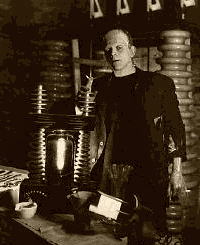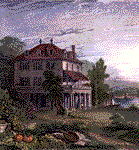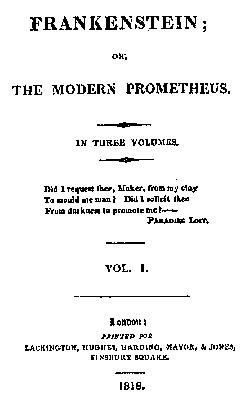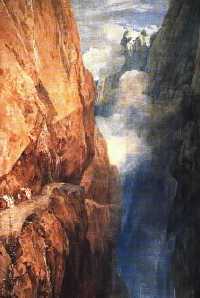|
|
|
|
 |
 |
|
|
|
|
      |
|
|
|
|
 |
- THE BOOK
• FRANKENSTEIN/E-BOOK (Project Gutenberg)
• FRANKENSTEIN MIND CHART (Word file, printable version 32 kb)
Dr Frankenstein is a brilliant
scientist
who is obsessed with the
idea of gaining
control over life and death,
refusing the
limits of contemporary
science. He carries
out his research alone
and unaided until
he eventually succeeds
in bringing to life
a monster he has created
out of the organs
of dead men. However, even
Frankenstein is
frightened when he sees
the fruit of his
insane fantasy. The monster
escapes from
the laboratory and appears
some time later
in the Swiss Alps where
he is rejected by
all the men that he encounters,
not so much
for his ugliness as for
his clearly non-human
features. His need to communicate
with others
is continually frustrated
and anger towards
all mankind builds up leading
to a tragic
climax in his killing of
Frankenstein's best
friend, his little brother
and his wife.
The monster takes refuge
at the North Pole
knowing that only there,
in a place of total
desolation he will kill
no more. Dr Frankenstein
follows him, intending
to kill his creation
but it is the doctor himself
who is mortally
wounded by the monster.
He accuses Dr Frankenstein
and the rest of mankind
of lacking all compassion.
The story ends with the
monster being borne
away on an ice raft in
the Arctic sea.
|
|
|
|
|
|
|
- GENESIS OF THE BOOK
The genesis of the novel
is due to particular
events which took place
in its author's life
in the summer of 1816 -
a temporary sojourn
in Geneva at Champagne
Chapuis near Villa
Diodati  in the stimulating company of Byron and other
intellectuals was occasion
of discussions
centred on Gothic tales
of horror as well
as on the origin and meaning
of life. The
germ of Frankenstein is
to be found in those
nightly conversations . in the stimulating company of Byron and other
intellectuals was occasion
of discussions
centred on Gothic tales
of horror as well
as on the origin and meaning
of life. The
germ of Frankenstein is
to be found in those
nightly conversations .
The first preface to the
novel Frankenstein was written by P.B. Shelley in 1817. In
the introduction to the
1831 edition of the
book, Mary Shelley tells
how the story was
begun in Geneva during
the summer of 1816.
"At first we spent our pleasant hours
on the lake, or wandering
on its shores;
…
But it proved a wet, ungenial
summer, and
incessant rain often confined
us for days
to the house."
The group of friends met in front of a blazing
fire during those wet evenings and recounted German ghost stories
to each other. The three
writers among the
group Shelley, Byron and
Mary Shelley decided
to write a story in imitation
of those which
they were reading and a
ghost story competition
was proposed by Byron.
That night Mary Shelley
was inspired by a visionary
dream. evenings and recounted German ghost stories
to each other. The three
writers among the
group Shelley, Byron and
Mary Shelley decided
to write a story in imitation
of those which
they were reading and a
ghost story competition
was proposed by Byron.
That night Mary Shelley
was inspired by a visionary
dream.
"When I placed my head on my pillow", the author writes, "I did not sleep, nor could I be said
to think. My imagination,
unbidden, possessed
and guided me, …"
with shut eyes but
acute mental vision…I saw
the hideous phantasm
of a man stretched out,
and then, on the
working of some powerful
engine, show signs
of life…On the morrow I
announced that I
had thought of a story."
The Swiss landscape impressed
and influenced
Mary Shelley in the writing
of her novel.
Particularly important
was the excursion
she made to Chamonix and
the Mer de Glace
which she used as the impressive
natural
background for chapters
IX and X.
It is interesting to consult
the diary of
Dr. Polidori, one of the
friends, regarding
the events leading up to
the genesis of Frankenstein.
June 15th … "Shelley and I had a conversation
about principles - whether
man was to be
thought merely an instrument.
June 16th … "Shelley
came and dined
and slept here, with Mrs
S(helley) and Claire
Clairmont"…
June 17th … "The ghost
stories are begun
by all but me…"
Certainly the book was
originally intended
to be a short story of
only a few pages.
However, Shelley himself
urged his wife to
develop it into a full-length
novel. From
Mary Shelley's Journal it can be seen that she wrote throughout
the month of August but
suspended on her
return to England in September.
She resumed work in December
but soon stopped
for her marriage to Shelley.
She then completed
the novel between March
and May 1817.
The manuscript was immediately
submitted
to a publisher by Shelley
on behalf of an
anonymous young author
but it was turned
down.
However, another publisher
- Lackington,
Allen and Company - accepted
it a month later.
The first edition appeared
in March 1818.
Early reviewers found it
rather shocking
and believed it likely
to be the work of
Shelley himself. Gradually
Mary Shelley's
authorship became common
knowledge.
|
|
|
|
|
|
|
- THE GOTHIC NOVEL
Mary Shelley's Frankenstein is one of the best examples of the Gothic
Novel. Even though it differs
in some aspects
from other Gothic tales,
nevertheless it
is obvious that the book
belongs to the Gothic
tradition.
 The Gothic tales grew in popularity at the
end of the 18th century
and they started
as an opposition to the
traditional realistic
works of writers such as
Richardson and Fielding. The Gothic tales grew in popularity at the
end of the 18th century
and they started
as an opposition to the
traditional realistic
works of writers such as
Richardson and Fielding.
The word "Gothic"
was associated
with the concepts of Medieval
and supernatural.
The plots of Gothic novels
were usually set
in the Middle Ages, and
the setting was represented
by ruins, haunted castles,
dark prisons,
monasteries which created
the "Gothic
gloom" with their
dark prisons, long
corridors, hidden passages.
The Gothic novelists
discovered the charm of
horror and the power
of the supernatural which
was created by
a particular mysterious
and frightening atmosphere
reinforced by the use of
supernatural beings
such as monsters or ghosts
and male characters
who are defeated because
of their negative
impulses. As a consequence
the main purpose
of Gothic novels was to
terrify the readers
rather than to amuse them.
Their plots were
centred around terrifying
descriptions and
extraordinary situations.
The origin of the Gothic
Novel refers to
1764, the year of the publication
of The Castle of Otranto by Horace Walpole. Gothic literature owes
much to Edmund Burke's
theories expressed
in his essay A Philosophical Enquiry into the Origin of
Our Ideas of the Sublime
and Beautiful.
In his essay he distinguishes
the concept
of the Sublime which he
associated with vastness
strength, gloom, fear and
the Beautiful which
he associated with harmony,
delicateness,
pleasure.
He stated that "terror was a source of the Sublime", "quell'orror bello che attristando piace" as the Italian poet Ippolito Pindemonte
described it.
The Gothic genre became so popular that it
continued to influence English writers and
today's horror novels come from the 18th
century Gothic tales.
|
|
|
|
|
|
|
"It was on a dreary night of November, that
I beheld the accomplishment of my toils.
With an anxiety that almost amounted to agony,
I collected the instruments of life around
me, that I might infuse a spark of being
into the lifeless thing that lay at my feet.
It was already one in the morning; the rain
pattered dismally against the panes and my
candle was nearly burnt out, when, by the
glimmer of the half-extinguished light, I
saw the dull yellow eye of the creature open;
it breathed hard, and a convulsive motion
agitated its limbs.
How can I describe my emotions at this catastrophe,
or how delineate the wretch whom with such
infinite pains and care I had endeavoured
to form? His limbs were in proportion, and
I had selected his features as beautiful.
Beautiful! - Great God ! His yellow skin
scarcely covered the work of muscles and
arteries beneath; his hair was of a lustrous
black, and flowing; his teeth of a pearly
whiteness; but these luxuriances only formed
a more horrid contrast with his watery eyes,
that seemed almost of the same colour as
the dun white sockets in which they were
set, his shrivelled complexion and straight
black lips."
[From Frankenstein, chapter V]
traduzione italiana
|
|
|
|
|
|
|
- THE THEME OF THE DOUBLE
"Two souls, alas, are housed within
my breast."
There are a lot of works concerning the theme
of the double, a device,
in fiction, which
enables us to examine and
explore the conflicts
of the personality. The
use of the double
expresses the opposition
between good and
evil as in Robert Louis Stevenson's Dr Jekyll and Mr Hyde, beauty and ugliness due to the passing
of time and immoral life,
as in Oscar Wilde's The Picture of Dorian Gray where the image of a portrait is the extension
of the self of the protagonist,
or reason
and instinct as in Mary
Shelley's Frankenstein.
In Frankenstein both characters, Victor Frankenstein and
the monster, share the
two opposite and complementary
sides of the human personality.
They are
two separate beings, but
existing in a relationship
of interdependence. That
is the reason for
the common mistake of thinking
that the name
Frankenstein is referred
to the monster,
and surely that is why
the monster has not
been given a name of his
own, it seems that
the nameless monster has
taken the name of
his creator.
Usurping the role women have in the process
of creation, Victor Frankenstein,
like a
neo-deity, works at his
creation establishing
a God-man and mother-son
dependence.
Victor Frankenstein's creature, the monster,
can be considered his alter
ego, the second
self, the product of his
meddling with nature
and of the insane attempt
to penetrate it
in order to find out all
the secrets of the
universe. The monster is
the result of the
destructive force which
is inside man particularly
inside the figure of the
mad scientist who
divorced from morality
in his pursuit of
knowledge. But, he is also
a victim of the
destructive forces of society
since he has
a good side, too. He is
the "bon sauvage"
educated through contact
with nature as Rousseau's
Emile. He is capable of
feeling emotions,
he is moved to tears at
the great sight of
a lovely spring day, nevertheless
he is conscious
of his deformity and he
knows that society
and his creator reject
him. The monster is
helpful, he saves a girl
but he is injured
and then he swears vengeance
to all mankind.
Like the best examples
of tragic heroes in
English literature, the
monster-Frankenstein
is composed of flaws and
virtues which melt
together inside the same
personality, flaws
which will finally lead
him to ruin. The
monster, in fact, reveals
himself to be a
homicidal creature beyond
his own control.
His revolt can be interpreted
as the right
punishment for the Faustian
overreacher side
of Frankenstein. Throughout
the novel the
two characters develop,
they reach the self-
knowledge typical of well-developed
characters,
they become one, turning
out to be conscious
of the evil they have done.
Both are filled
with a sense of remorse
at the crimes they
have committed so that
at the end of the
novel they might exclaim
"The horror!
The horror!" like
Joseph Conrad's Kurtz, the protagonist of Heart of Darkness. How superb is the moment of self-consciousness!
Moreover, the monster reflects Victor Frankenstein's
condition as a human being,
and the quotations
from John Milton's Paradise Lost which appear under the title of the book,
may apply to Victor Frankenstein
as well
as to his creature:
"Did I request
thee, Maker, from
my
clay
To mould me Man?
Did I solicit thee
From darkness to
promote me?"
|
That's the universal question every man could ask his Creator,
the human revolt, the accusing
words of a
fallen Adam to his Creator.
Not only the
monster, but Victor Frankenstein
may be considered
a fallen Adam and a fallen
Lucifer, too,
as we can see from his
words:
" … The apple was already eaten, and
the angel's arm bared
to drive me from
all
hope"
…like the archangel
who aspired to omnipotence,
I am chained in an
eternal hell"
|
The parallel between the two beings is now
completed and the consequent
equation shows
that the monster is to
Victor Frankenstein,
as Frankenstein is to his
Creator.
In the same way that Frankenstein corrupts
the monster by his rejection,
so Frankenstein
is led to corruption by
whatever divine power
created him. The monster's
condition of corrupted
benevolence may also be
referred to Frankenstein's.
|
|
|
|
|
|
|
- VICTOR FRANKENSTEIN AND HIS CREATURE
THE MODERN SCIENTIST
Frankenstein is a Modern Prometheus but he
is also a new Faust.
The association of Victor Frankenstein with
the figure of Faust is
particularly evident
in the description of modern
scientists:
"…they penetrate into the recesses of
nature and show how she
works in her hiding-places.
They ascend into the heavens:
they have discovered
how the blood circulates,
and the nature
of the air we breathe.
They have acquired
new and almost unlimited
powers" (from chapter III)
The author poses the question of the moral
responsibility of the scientist
when his
discoveries go beyond his
control, beyond
the limits of human knowledge:
"Learn from me, if not by my precepts,
at least by my example,
how dangerous is
the acquirement
of knowledge and how much
happier than man
is who believes his native
town to be the
world, than he who aspires
to become greater
than his nature will allow" (from chapter IV)
THE OUTCAST OF SOCIETY
Frankenstein's creature, the monster, is
the expression of social
injustice and refers
to Rousseau's conception
of man as originally
good. The creature he creates
becomes a symbol
of Romantic concern for
the isolation of
the individual by society.
As long as he
does not come into contact
with society,
in fact, the monster shows
love and generosity
towards everybody. The
monster wanders about
the country full of curiosity
and benevolence,
but he is very soon disappointed
and wounded
by the horror and hostility
with which people
react at his sight. He
lives in solitude
and learns to speak and
to read by observing
a family who inhabits a
small cottage. But
his horrible aspect frustrates
his attempt
at making friends. He soon
finds himself
rejected because of his
hideous appearance
becoming the symbol of
the outsider, rejected
by society because of his
"difference".
So, the creature is turned
into a monster
by human prejudices. People's
rejection of
the monster shows that
HUMAN BEINGS JUDGE
OTHERS BY THEIR OUTWARD
APPEARANCE.
And he is emotionally involved when he exclaims:
"Once I falsely hoped to meet with beings
who, pardoning my outward
form, would love
me for the excellent qualities
which I was
capable of unfolding" (from chapter XXIV )
He is not capable of going on living in total
isolation because his life
is unbearable.
But the monster is not a mere object of repulsion
and terror but a complex
being with a profound
psychological side.
Some of its features derive from the heroes
of Gothic novels, exemplified
best not in
a novel but in Byron's poem Lara. The protagonist of this Oriental Tale is a pirate chief. He is a taciturn and
brooding character who
feels himself to be
a stranger in the world.
His life has been
adventurous and wild and
now he appears isolated
from the rest of society,
in his opinion
a victim of fate and nature,
not of his own
faults. He lives among
other people but as
if he were alone.
He perfectly embodies the Byronic hero.
Those who see him can never forget his cold
and mysterious aspect and
behaviour nor can
they penetrate his soul
to understand what
lies below the aloof exterior.
Dr Frankenstein
"It was the secret of heaven and earth
that I desired to
learn"
(Frankenstein, chapter IV)
"I, John Faustus of Wittenberg, Doctor,
by these presents,do
Give both body and soul to Lucifer, Prince
of the East, and
his Minister Mephostophilis,
and furthermore grant
unto them That four
and twenty years
being expired, and
these
articles Above written
being inviolate,
full
power to fetch or
carry the Said John
Faustus,
body and soul, flesh,
blood,or goods, into
Their habitation,
wheresover.
(Doctor Faustus, II.i.) |
|
The Monster
"All men hate the wretched; how, then,
must I be hated, who am miserable
beyond all living things"
(Frankenstein, chapter X)
"There was in him a vital scorn of all:
as if the worst had fall'n which
could befall, He stood a stranger in this
breathing world,
An erring spirit
from another
hurl'd"
(Lara, lines 313-316) |
|
|
|
|
|
|
|
- FILMOGRAPHY
- Mary Shelley's Frankenstein (US, 1994). Directed by Kenneth Branagh,
starring Robert De Niro,
Kenneth Branagh,
Helena Bonham Carter.
- Young Frankenstein (US, 1974). Directed by Mel Brookes, starring
Gene Wilder, Peter Boyle,
Marty Feldman.
- Frankenstein the True Story (GB, 1973). Directed by Jack Smight, starring
James Mason, Leonard Whiting,
David McCallum,
Jane Saymour.
- The Son of Frankenstein (US, 1939). Directed by Rowland V. Lee, starring
Boris Karloff,
Bela Lugosi, Baril Rathbone.
- The Bride of Frankenstein (US, 1935). Directed by James Whale, starring
Boris Karloff,
Colin Clive, Valerie Hobson.
- Frankenstein (US, 1931). Directed by James Whale, starring
Boris Karloff, Colin Clive.
|
|
|
|
|
|
|
|
|
|
[top] |
|
|
|